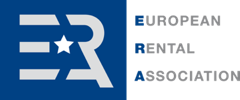Green and digital trends

Since the start of the Covid-19 pandemic crisis, the closure of construction sites and cancellation of events across Europe have had severe consequences for the equipment rental industry.
Until 2019 and even into the first quarter of 2020, the European equipment rental market had been showing robust growth – above 4% for Europe overall – led by strong results in markets like Poland, Italy, and Germany. Covid-19 has overturned this trend and led to an estimated downturn of -10% in 2020 across the 15 countries analysed in ERA’s 2020 Market Report, which represents 95% of Europe’s equipment rental market.
Besides this economic shock, the crisis is also having, and will continue to have, an impact on several fundamental trends for the industry. One of them is digitalisation, which was already one of the main technological factors impacting the sector. Telematics and connected machines are fuelling data generation, improving efficiency and opening up new opportunities for rental companies.
Rental fleet management, administration and customer transactions are also increasingly moving online, driven by new e-commerce and other digital solutions. This trend has been fast-tracked by the current crisis, which has accelerated the need for such remote technologies.
Climate goals
Another significant trend is sustainability and the push for the construction sector to decarbonise in order to meet the Paris climate goals. This pressure did not disappear with the Covid-19 crisis, with investors and regulators emphasising the need for a green recovery.
The rental industry has taken this opportunity to highlight its environmental benefits. As shown by a recent independent study, rental can reduce carbon emissions from construction equipment by 30% or more, depending on how the equipment is used.
There are a number of ways in which rental lowers emissions, including through adequacy (ensuring the right tool for the job), transportation of the equipment (minimising travel distances and optimising load factors), equipment utilisation (maximising the utilisation rate) and maintenance (improving efficiency and service life).
At the nexus of these trends, ERA has been looking to leverage digital solutions to encourage the take up of green, low carbon and circular practices. In early 2021, ERA will release a new digital tool to measure the carbon footprint of construction equipment.
The ERA Equipment CO2 Calculator will enable companies to make efficient and environmentally friendly choices when using construction equipment. This new tool will be particularly relevant in a context where construction projects will likely have to demonstrate their sustainability.
Growth for 2021
As for the larger prospects going into 2021, the outlook for the construction sector will largely depend on whether there are any further lockdowns, local or temporary restrictions, as well as investments in infrastructure and building projects.
For the equipment rental sector specifically, we are optimistic that this year’s economic downturn will be followed by a period of growth due to the fact that rental eliminates the financial risk of investing in expensive equipment, freeing up capital for equipment users to grow their businesses.
This is also good news for the larger digitalisation and sustainability push, with an increasing understanding that renting construction equipment, as a smart and circular economy model, can help reduce emissions, achieve the Paris climate goals and aid a green recovery.
This article was first published in the International Construction (December 2020).
